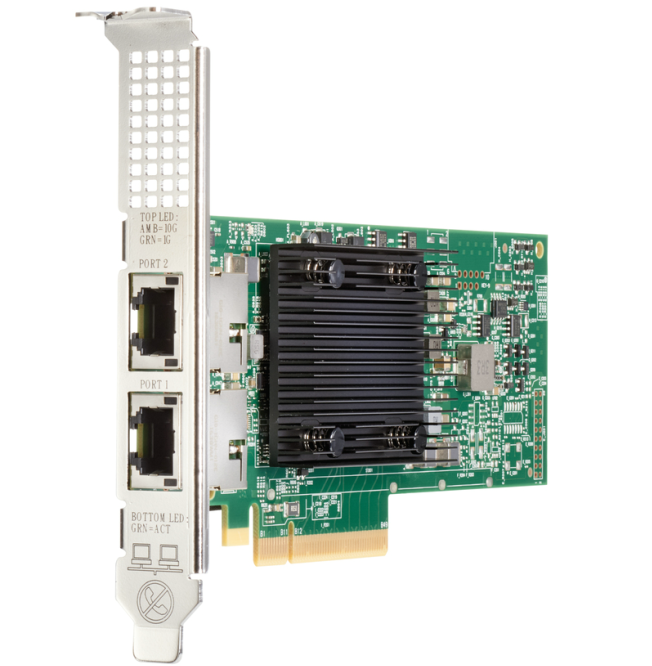Are you looking for an easy and cost effective transition to 10GBASE-T with enhanced security features? The HPE Ethernet 10GBASE-T 2-port 535 Adapters utilize CAT 6A cabling with distances up to 100 meters and is backward compatible to existing 1GBASE-T infrastructure. This allows quick and easy incremental improvement of network speed without either changing the cables or major upgrade of equipment. These adapters help prevent, detect and recover from cyber attacks by protecting applications, data and server infrastructure by authenticating digitally signed firmware via a Root of Trust architecture. In addition, they offer Secure Boot, Device-level Firewall and other advanced security features.

https://h20195.www2.hpe.com/v2/gethtml.aspx?docname=a00008516enw
1. At a Glance Features
Dual 10Gb ports provide up to 40 Gb/s of bi-directional Ethernet bandwidth
Jumbo Frame
FlexibleLOM (535FLR-T) and Stand up (535T)
HPE Sea of Sensors 3D
Tunnel Offload(NVGRE and VXLAN)
RDMA over Converged Ethernet (RoCE v1, RoCE v2)
Single-root input/output virtualization (SR-IOV)
IPv6 Acceleration
Preboot eXecution Environment (PXE)
Wake on Lan (WOL)- (only 535FLR-T)
Checksum & Segmentation Offload
VMware NetQueue and Microsoft Virtual Machine Queue (VMQ)
Data Plane Development Kit (DPDK)
Receive-Side Scaling (RSS)
Large Receive Offload (LRO), Generic Receive Offload (GRO), Receive Side Coalescing (RSC)
Accelerated Receive Flow Steering (aRFS)
Active Health Systems support
Security features - digitally signed firmware components, secure firmware loading, secure firmware update, UEFI secure boot
Authentication of digitally signed firmware through true HW Root of Trust and Chain of Trust on the NIC
Additional Security features include: Device-level Firewall, Audit Logs and Sanitization
2. Checksum & Segmentation Offload
Normally the TCP Checksum is computed by the protocol stack. Segmentation Offload is technique for increasing outbound throughput of high-bandwidth network connections by reducing CPU overhead. The technique is also called TCP segmentation offload (TSO) when applied to TCP, or generic segmentation offload (GSO).
3. DPDK
This adapter supports DPDK with benefit for packet processing acceleration and use in NFV deployments.
4. Jumbo Frames
This adapter supports Jumbo Frames (also known as extended frames), permitting up to a 9,600 byte (KB) transmission unit (MTU) when running Ethernet I/O traffic. This is over six times the size of a standard 1500-byte Ethernet frame. With Jumbo Frames, networks can achieve higher throughput performance and greater CPU utilization. These attributes are particularly useful for database transfer and tape backup operations.
5. RDMA
This adapter supports RoCE v1 and v2. RoCE v2, also sometimes called "Routable RoCE" which adds Concurrent RoCE v1 and v2 support, SR-IOV support, QoS with hierarchical TX scheduling, ECN-based congestion control for RoCE v2. RoCE is an accelerated I/O delivery mechanism that allows data to be transferred directly from the user memory of the source server to the user memory of the destination server bypassing the operating system (OS) kernel. Because the RDMA data transfer is performed by the DMA engine on the adapter's network processor, the CPU is not used for the data movement, freeing it to perform other tasks such as hosting more virtual workloads (increased VM density). RDMA also bypasses the host's TCP/IP stack, in favor of upper layer InfiniBand protocols implemented in the adapter's network processor. The bypass of the TCP/IP stack and the removal of a data copy step reduce overall latency to deliver accelerated performance for applications such as Microsoft Hyper-V Live Migration, Microsoft SQL and Microsoft SharePoint with SMB Direct.
6. Single-Root I/O Virtualization
Single-Root I/O Virtualization (SR-IOV) provides a mechanism to bypass the host system hypervisor in virtual environments providing near metal performance and server efficiency. SR-IOV provides mechanism to create multiple Virtual Functions (VFs) to share single PCIe resources. The device is capable of SR-IOV, and requires Server BIOS support, controller firmware, and OS support.
7. Tunnel Offload
Minimize the impact of overlay networking on host performance with tunnel offload support for VXLAN, NVGRE and GENEVE. By offloading packet processing to adapters, customers can use overlay networking to increase VM migration flexibility and virtualized overlay networks with minimal impact to performance. HPE Tunnel Offloading increases I/O throughput, reduces CPU utilization, and lowers power consumption. Tunnel Offload supports VMware's VXLAN, Microsoft's NVGRE solutions and Generic Network Virtualization Encapsulation (GENEVE) solutions.
8. VMware NewQueue and Microsoft Virtual Machine Queue (VMQ)
VMware NetQueue is technology that significantly improves performance of 10 Gigabit Ethernet network adapters in virtualized environments.
Windows Hyper-V VMQ (VMQ) is a feature available on servers running Windows Server 2008 R2 with VMQ-enabled Ethernet adapters. VMQ uses hardware packet filtering to deliver packet data from an external virtual machine network directly to virtual machines, which reduces the overhead of routing packets and copying them from the management operating system to the virtual machine.
9 .Network Processor
Broadcom BCM57416

文章评论